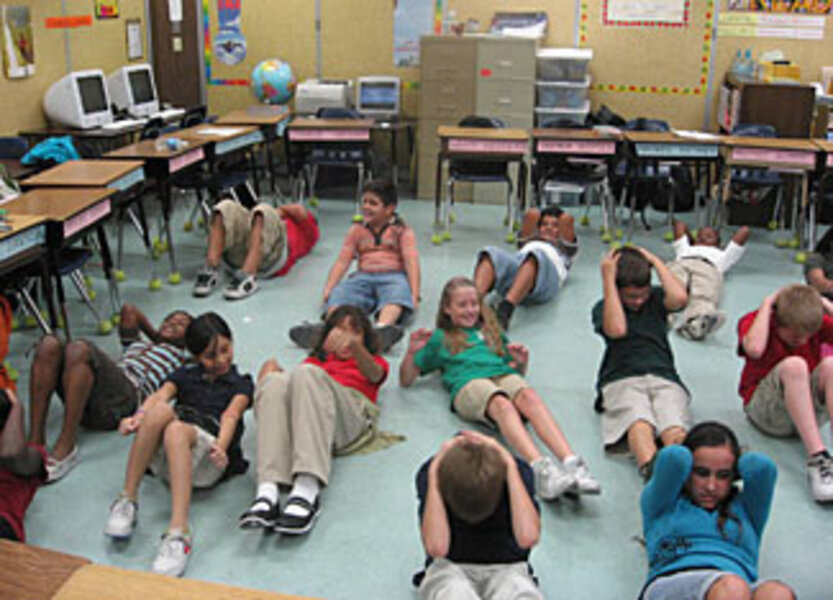Florida fights childhood obesity with new gym rule
| Coral Springs, Fla.
James Destilus and Kenneth Gutierrez want to be on the football team when they move up to middle school next year. Mike Lawson prefers basketball. And Lauren Rebaza and Jhullyza Calderon will try out for swimming.
The fifth-graders might have different sporting ambitions, but they're working toward their goals in the same way: strutting around their classroom, flapping their arms like roosters, and singing at the top of their voices to a song called "Chicken Fat."
It's great fun for the students, but this unorthodox approach to fitness also has its serious side. It helps the school, Forest Hills Elementary in Coral Springs, Fla., comply with a state law that came into effect this semester requiring children in kindergarten through fifth grade to receive 30 minutes of continuous physical education every day.
While efforts within the education system to curb soaring rates of childhood obesity are not new, Florida's recent inclusion of the word "continuous" presents a specific difficulty to schools trying to juggle already crowded curricula.
Before the law was implemented, there were reports of some schools including the children's walk to the cafeteria at lunchtime as part of a looser requirement of 150 minutes' exercise, in any combination, per week.
"There's no doubt this was a challenge, and we had a lot of planning to do, sitting down with our teachers to find a way to get this exercise in without disrupting their schedule," says Vince Dawes, assistant principal of Forest Hills Elementary, which has 620 students.
"The teachers rose to the challenge, and the kids love what they're doing," Mr. Dawes says. "I walk around the school, and I'll hear a lot of noise and music from somewhere, and wonder, 'what was that?' And there will be a class full of kids jumping up and down with big smiles on their faces."
Forest Hills, which is part of the Broward County Schools District, came up with some of the most creative responses to the new requirement, according to Elly Zanin, curriculum specialist in physical education for the district.
One of Forest Hills' first steps was finding space in the timetable. Each class now uses daily recess for formal PE, whether that is yoga, pilates, or routines like "Chicken Fat," which fifth-grade teacher Patricia Purvin prepared for her class.
Videos entitled "Forest Hills Fever" are also shown daily. The 30-minute programs are professionally produced outside the school and feature a variety of activities, of which the children say they prefer mock martial-art routines.
And parts of the Forest Hills schoolyard have been transformed from general playground to "designated outdoor fitness areas" for activities under the guidance of PE teacher Joseph Alfonso, who sees each class at least once a week. In better weather, this is where Mrs. Purvin's class would usually be flapping to the chicken dance or performing another favorite, the "Cha Cha Slide."
The Broward school district has "one of the shortest school days, and of course it's a challenge to fit it in alongside the academic demands," Ms. Zanin says. "That's why the schools have had to be creative."
With no extra time in the school day, and no extra funding for the law, necessity has become the mother of invention. Take one of Broward County's new lesson plans that is recommended to elementary schools: Students perform PE during the math segment by circling the classrooms and stretching to measure desks, windows, and white boards.
At Gilchrist Elementary School in Tallahassee, PE teacher Neeley Knight has adopted a "learning through movement" program called "Brain Gym," which uses stretching exercises to try to improve thought and mental capacity.
In Polk County, according to PE curriculum coordinator Don Knitt, several schools are integrating PE with academic lessons in other ways. "Our focus is not to reduce physical education time but to concentrate on activities that will help improve their learning ability," he says. "PE supports other academic disciplines."
Also, fitness doesn't stop with the children. The Broward school district encourages its staff to take up its provision of free membership in a national gymnasium chain, as well as to participate fully in their students' exercise sessions.
"It gives me a good workout, too," says Purvin, who claims to be fitter than ever to pursue her outside hobby of line dancing. "But teachers are excused jumping," she jokes.
Lauren, one of the students who wants to try out for swimming, thinks it's "cool" that her teacher not only choreographs the class sessions, but leads them, too. "It shows us that it's important to stay active and get stronger for when we're older," says the 10-year-old, who also exercises with weekend Frisbee games and long walks with the family dog.
Experts in childhood obesity agree that schools alone cannot solve a problem in which the percentage of overweight 6- to 11-year-olds in the US has leapt from 6.5 in 1980 to 18.8 a decade and a half later, according to the most recent figures from the Centers for Disease Control and Prevention (CDC).
"The law in Florida is a good one, and it's definitely a step in the right direction," says James Sallis, professor of psychology at San Diego State University and program director of Active Living Research at the Robert Wood Johnson Foundation.
"By itself it won't solve anything. Neither will removing vending machines from schools nor improving school lunches," Professor Sallis says. "But take those things together and encourage children to walk or cycle to school, make them more active after school and at weekends, and you begin to make progress."
He also cautions, "My issue is that a lot of elementary school teachers have responsibility for PE teaching, but may not have the training. Students might get 30 minutes of PE, but it might not be of good quality."
Florida's aim is to guide its youngest students away from a path leading to the state's 11 percent of high school students who are obese, according to the CDC.
"We need to be teaching children to make good, solid, healthy choices early in life so they can form the habits that will last a lifetime," says Sterling Ivey, spokesman for Charlie Crist (R), Florida's governor.
Crist, a former high school quarterback who prides himself on his own physical fitness, is backing up the elementary school initiative with the eight-week Governor's Fitness Challenge, which is scheduled to begin in January and encourages elementary and middle schools to take part in physical exercises and tests.






